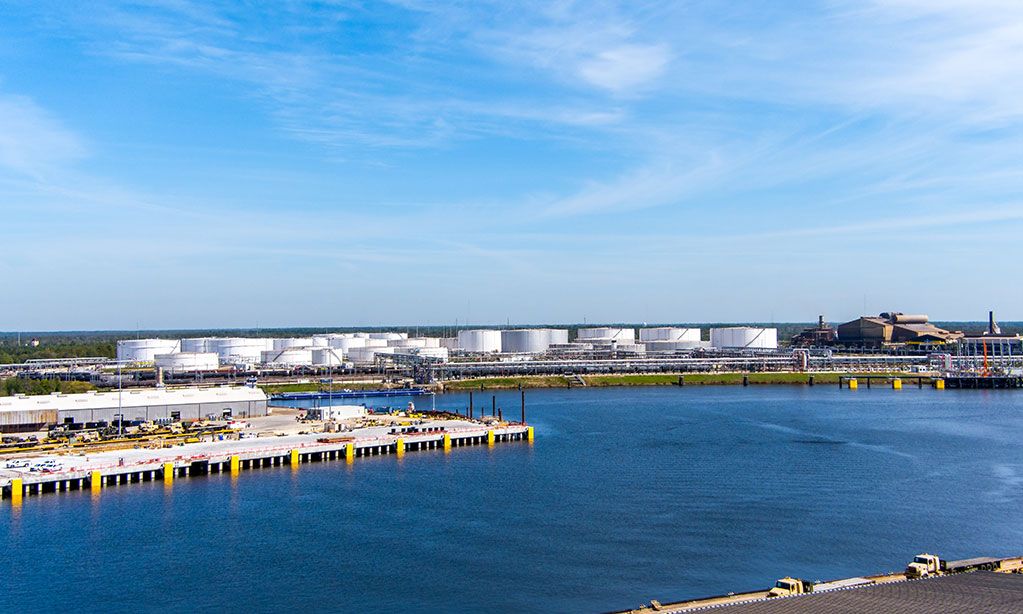

Facility Response Plans for Worst-Case Scenario Discharges of Hazardous Substances
Responsibility for preventing spills and having plans to clean up any spills that inevitably happen has been a key part of many EPA regulations for decades. Whether it is for the protection of air, land or water; safeguarding the environment begins at the facility level.
On March 28, 2024, the EPA finalized a new regulation requiring certain facilities that store hazardous substances to prepare worst-case scenario response plans (40 CFR 118). This is not an uncommon requirement. However, this rule is one of the first that specifically requires facilities to consider adverse weather conditions when planning for their worst-case event.
Rule Overview
The Clean Water Act Hazardous Substances Facility Response Plans Rule acknowledges that about 80% of facilities that store large quantities of Clean Water Act (CWA) hazardous substances (40 CFR 116.4) are located within ½ mile of waterways. Because of their proximity to water, these facilities often have the potential to cause serious harm to both drinking water and aquatic ecosystems.
Affected facilities must be prepared to handle a worst-case scenario discharge. This means they need to have trained personnel and spill response materials available and ready for response. Facilities may contract response services, but those resources must be able to respond quickly in the event of a discharge.
Adverse weather events, including those caused by climate change, must be considered as facilities develop their worst-case scenarios. The term “adverse weather” is defined slightly differently than it is in the Oil Pollution Prevention Rule (40 CFR 112.2), and is intentionally broad because it is meant to encompass the different regional weather patterns that occur throughout the United States. Some of the factors that facilities may need to consider are:
- Increased frequency and intensity of weather events
- Temperature fluctuations
- Rising seas
- Storm surges
- Inland and coastal flooding
- Droughts
- Wildfires
- Permafrost melt (40 CFR 118.2)
Existing facilities have a 36-month implementation period to develop their plans, conduct training and gather response resources. Plans must be implemented by June 1, 2027. The rule also establishes implementation timetables for new facilities and existing facilities that become newly regulated.
Rule Applicability
- Threshold Quantity: the facility has 1,000 times the Reportable Quantity (RQ) of any of the 296 listed CWA hazardous substances at 40 CFR 116.4 onsite at any time.
- Proximity to Navigable Waters: the facility is located within ½ mile of navigable waters or has a conveyance (ex. storm drains, pipes, channels) with an opportunity for discharge within ½ mile of navigable waters.
- Substantial Harm Criteria: a discharge could cause injury to fish, adversely impact a public water system, cause injury to public receptors (parks, recreational areas, docks or other public spaces); or the facility has a reportable discharge history.
Facilities that do not meet these three criteria may still become subject to regulation if the EPA Regional Administrator determines they could cause significant or substantial harm. Any member of the public or any federal, state or local agency may also petition for facilities to be considered if they have the potential to cause substantial harm to a waterway.
Some facilities with hazardous substances are exempt from this regulation because they are already required to have adequate prevention and response plans to comply with other regulations including:
- Equipment or operations of vessels subject to Department of Transportation (DOT) regulations
- Equipment and operation of vessels subject to US Coast Guard or US Department of the Interior regulations
- Transportation, Storage and Disposal Facilities (TSDFs) regulated by 40 CFR 264 or 265
- Large Quantity Generators (LQGs) of Hazardous Waste regulated by 40 CFR 262
- Underground Storage Tanks regulated by 40 CFR 280
- Discharges regulated by a National Pollutant Discharge Elimination System (NPDES) Permit
Facility Response Plan Requirements
When the CWA was amended in 1990 to include the Oil Pollution Act (OPA 90) requirements, one of the chief objectives was to make facilities that use and store oil primarily responsible for responding to releases – not the public (using local, regional, state or federal resources.) Similarly, this rule requires facilities with hazardous substances to take the lead in response efforts.
A facility’s response plan must:
- Be consistent with the National Contingency Plan (NCP) and Area Contingency Plans (ACP);
- Be updated periodically; and
- Be resubmitted for approval every five years or when there is a substantial change at the facility
To facilitate both training of personnel and response efforts; facilities may adapt or amend existing plans to include the information required by this regulation.
An Emergency Response Action Plan [40 CFR 118.11(c)] must be kept in front of the plan or as a separate binder. This Plan summarizes the actions that the facility will take to mitigate discharges, lists notifications that will be made, outlines evacuation procedures and provides other critical information that is needed in the first two hours of a response.
Because worst-case scenario responses often require local, state and sometimes even federal resources to supplement the facility’s efforts; facilities must coordinate plans with appropriate Local, State and Tribal Emergency Response Committees/Commissions. Facilities need to maintain documentation of coordination efforts and are encouraged to use ASTM E3241–20 Standard Guide for Coordination and Cooperation between Facilities, Local Emergency Planning Committees, and Emergency Responders as a guide for their coordination efforts.
Facility Response Plan Elements
-
Facility Information
-
The name of the facility and its location
-
Contact information for owners/operators
-
Substantial Harm Criteria Form
-
Facilities must complete Appendix A and include a declaration that the owner/operator is aware of the plan and their commitment to deploy resources
-
Hazard Evaluation
-
Evaluate the types of adverse weather that may occur
-
Calculate worst-case discharge endpoints
-
Document effects of an instantaneous release as well as release over time
-
Assess the age of CWA hazardous substance containers, since older containers may be more susceptible to failure
-
Document taste or odor thresholds in water
-
Identify nearby schools, businesses, places of worship, or other areas that could be impacted by a worst case discharge
-
Determine the effects of a worst case discharge on communities with environmental justice concerns as well as those affected by climate change
-
Include illustrative diagrams that show impact zones
-
Reportable Discharge History
-
Information must be retained for the life of the facility
-
Informs scenario development
-
Includes lessons learned from past CWA hazardous substance discharges and response efforts
-
Qualified Individual
-
Person(s) with full authority to implement response actions
-
Communicates with outside resources
-
Has intimate knowledge of the facility and its operations
-
Must acquire and maintain incident commander training requirements consistent with OSHA’s HAZWOPER standard
-
Response Personnel and Equipment
-
Lists of response-trained personnel and their contact information
-
Descriptions of equipment that will be necessary to respond to a discharge
-
Personnel Roles and Responsibilities
-
Capabilities or response personnel
-
Duties of facility personnel
-
Training and qualifications
-
Response times
-
Response Equipment Information
-
The equipment’s role in response
-
The location of the equipment
-
Inspection or test dates for the equipment
-
Deployment dates or frequencies
-
Contracts
-
Explicitly requires response resources to have firefighting capabilities
-
Identity of the facility individual who will work with the local fire department or other contracted resources during response efforts
-
Evacuation Plans
-
Facility-wide diagrams for evacuation with check-in areas for accountability
-
Documentation of coordination with community plans
-
Locations of CWA hazardous substances and their flow directions when discharged
-
Limitations on evacuation routes
-
Transportation routes to medical facilities
-
Command center locations
-
Shelter locations
-
Notification Lists
- Identities, contact information and preferred method of contact for individuals and organizations to be contacted, including:
- National Response Center
- Qualified individual
- Facility response team members
- Local response teams
- Fire marshal
- State or Tribal Emergency Response Commission
- State Police
- Downstream public water systems
- Local media
- Local hospitals
- Other potential receptors or interested parties
-
Discharge Information
-
Information about the discharged substance, possible receptors and any other information that responders and the public may need regarding the discharged substance
-
Discharge Detection Systems
-
Procedures or equipment that will be used to detect and monitor air releases
-
Both proactive (detection) and reactive (monitoring after a release) systems should be identified
-
Response Actions
-
List response actions to be carried out by facility or contracted personnel
-
Describe air monitoring and water sample collection, including analytical methods and laboratory support
-
An assurance that all workers will abide by a health and safety program consistent with 29 CFR 1910.120 during response
-
Documentation of response actions to be taken within one- and two-hours of discharge detection
-
Disposal Plans
-
Recovery, reuse, decontamination, treatment and disposal plans for contaminated cleanup materials, contaminated soil and water, equipment and response materials
-
Containment Methods
-
List containment structure volumes, drainage routes materials used for containment
-
Specify capacity and construction of valves, pumps, separators, drainage systems, booms and weirs
-
Training, Testing, Drills and Exercise Procedures
-
Facility personnel, private personnel, casual laborers and volunteer responders must be HAZWOPER-trained
-
Describe training programs, equipment testing, drills and response actions
-
Perform functional drills and document evaluation procedures
-
Coordinate drills with local public emergency response officials
-
Self-Inspection
-
Written procedures and records of inspections
-
Checklists and means to record dates and findings
Preparing and Revising Plans
The EPA has provided a 36-month implementation period to allow facilities the time necessary to develop realistic worst-case scenario predictions, create plans, train personnel and acquire necessary resources. Facilities with robust spill response plans may already have many of the required elements in their plans.
With the renewed focus of having the response begin at the facility level, not with public responders; the longer implementation period also gives facilities time to coordinate plans with local responders and educate the public on potential impacts and response expectations.
Related Articles
Subscribe for Updates:
Sign up here to get the latest news, rules, and regulations and delivered right to your inbox.